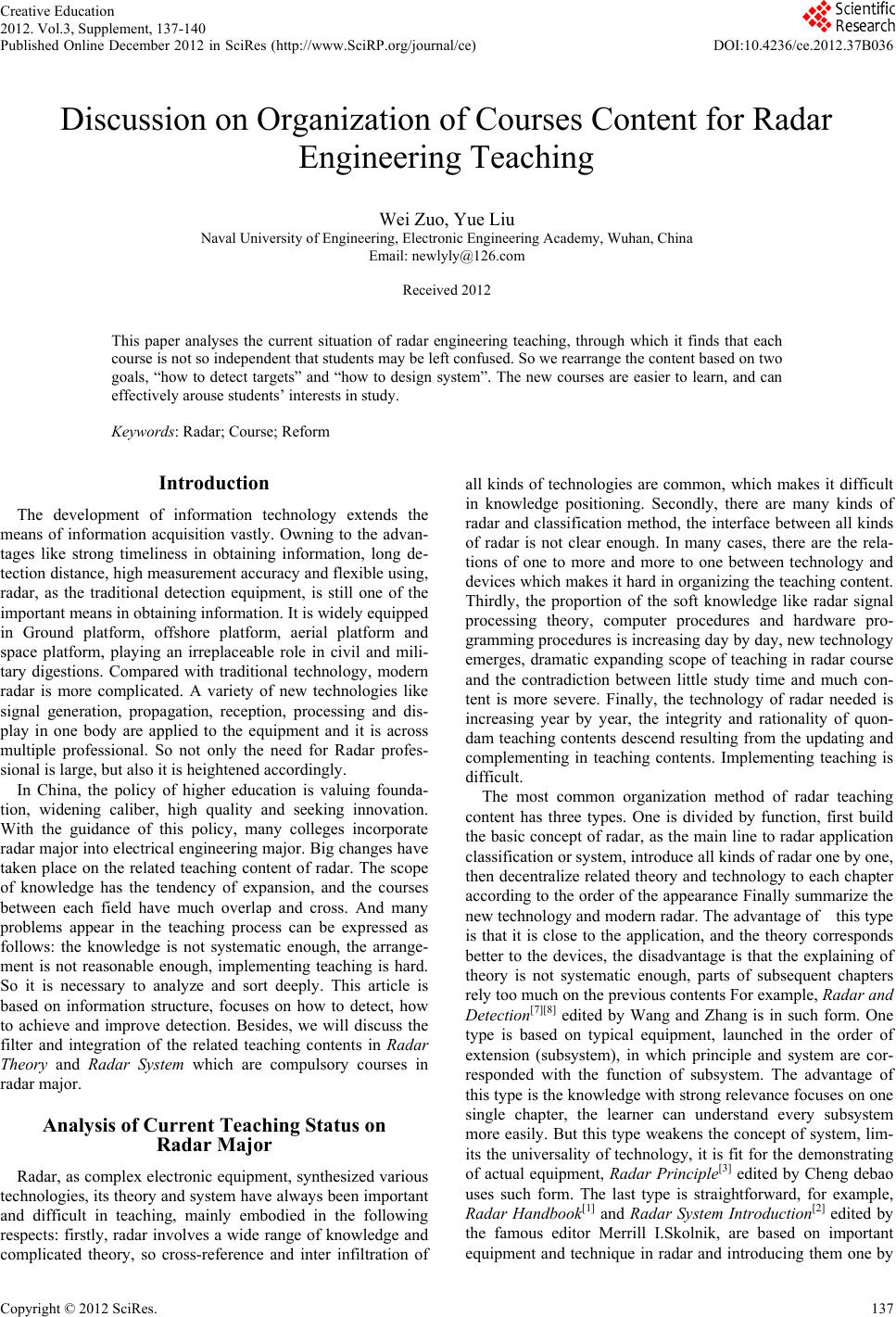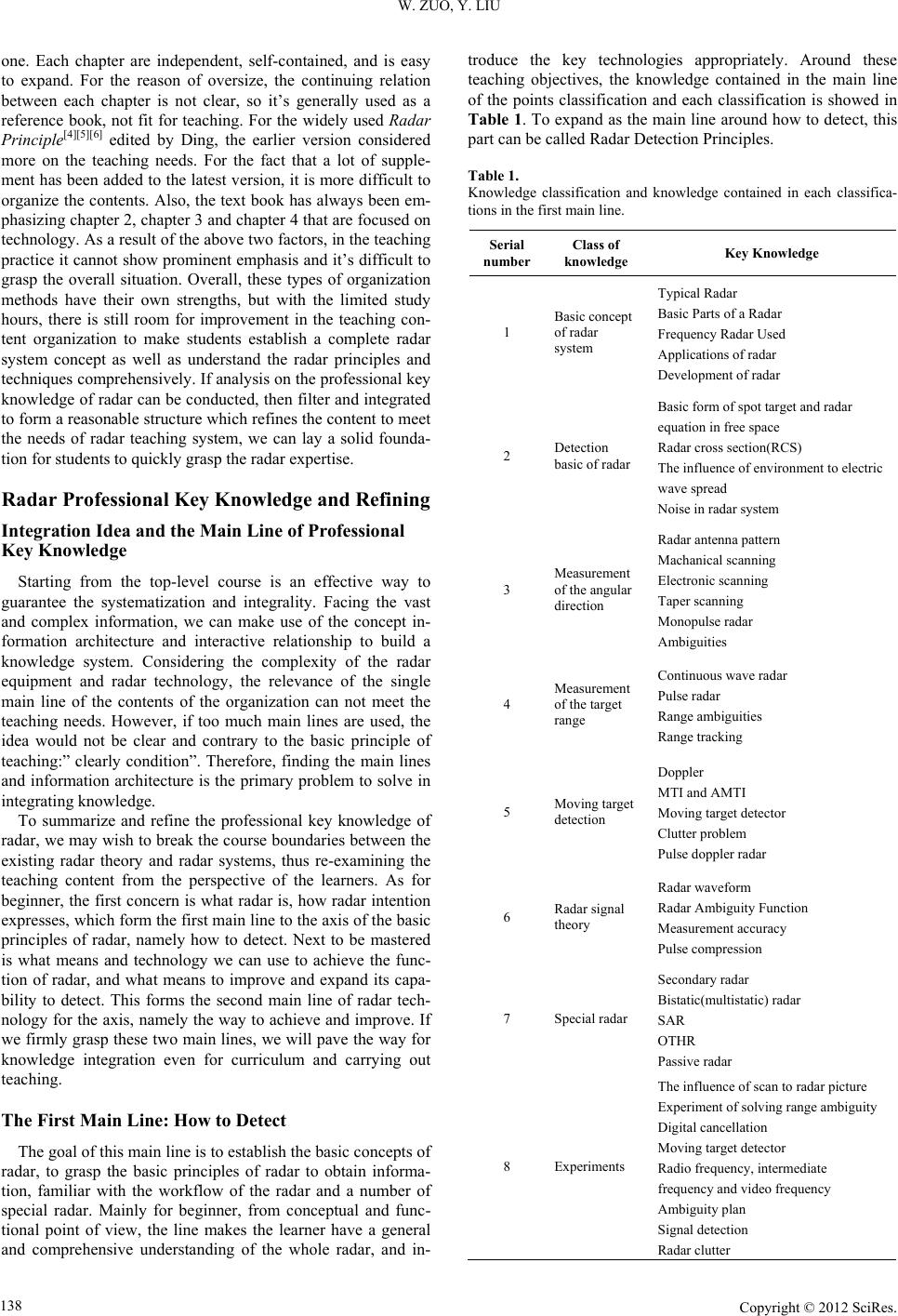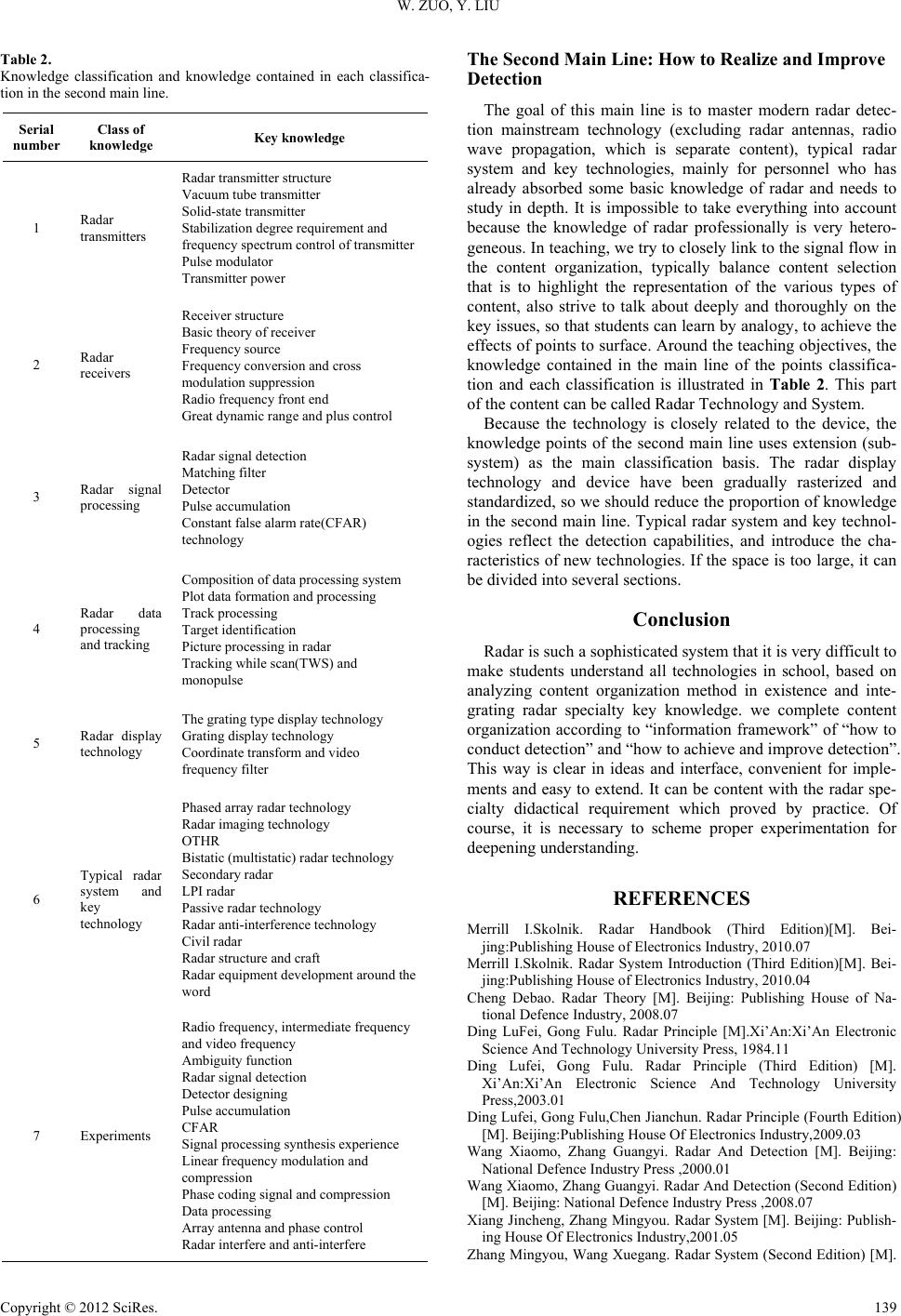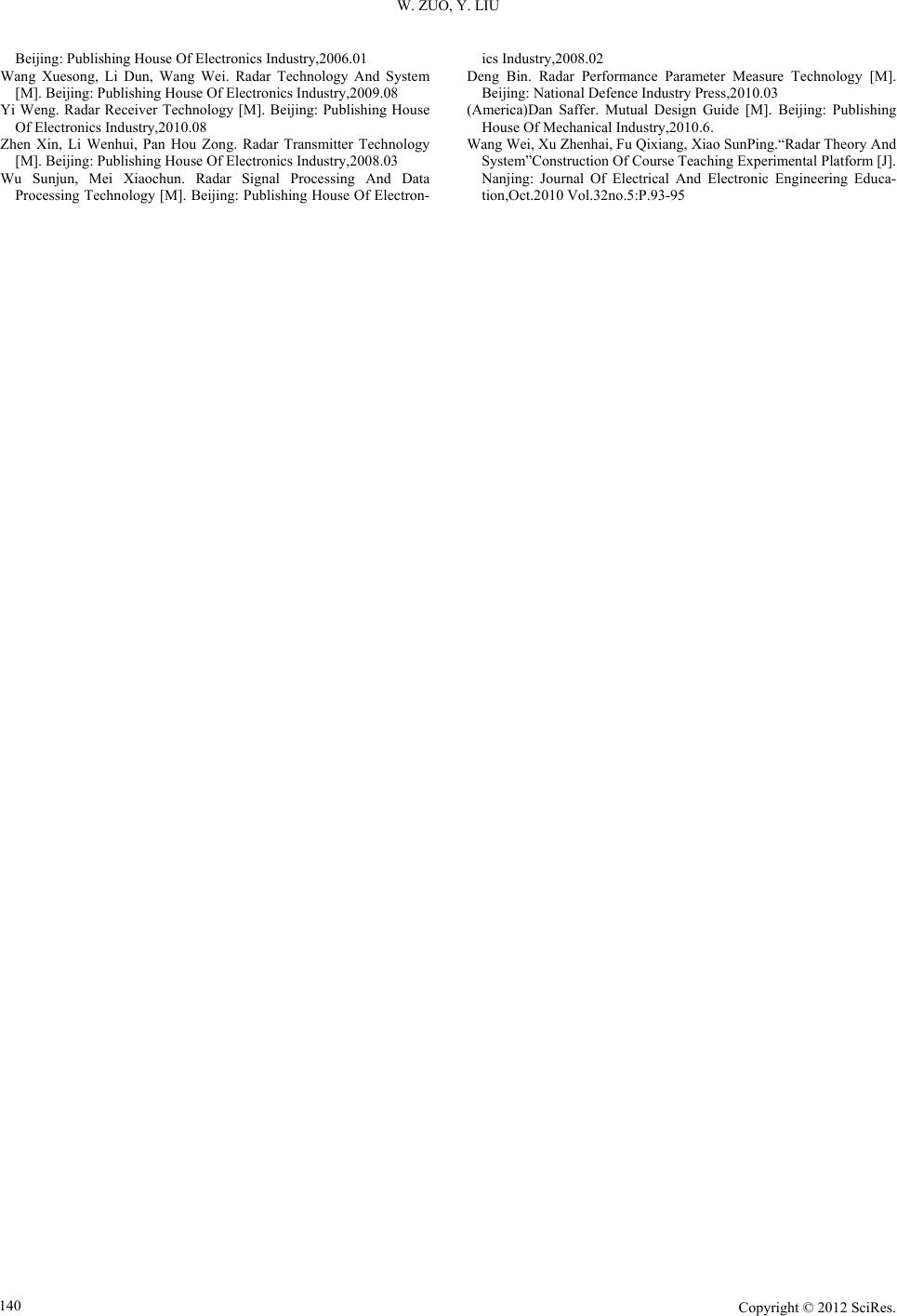Paper Menu >>
Journal Menu >>
 Creative Education 2012. Vol.3, Supplement, 137-140 Published Online December 2012 in SciRes (http://www.SciRP.org/journal/ce) DOI:10.4236/ce.2012.37B036 Copyright © 2012 SciRes. 137 Discussion on Organization of Courses Content for Radar Engineering Teaching Wei Zuo, Yue Liu Naval University of Engineering, Electronic Engineering Academy, Wuhan, China Email: newlyly@126.com Received 2012 This paper analyses the current situation of radar engineering teaching, through which it finds that each course is not so independent that students may be left confused. So we rearrange the content based on two goals, “how to detect targets” and “how to design system”. The new courses are easier to learn, and can effectively arouse students’ interests in study. Keywords: Radar; Course; Reform Introduction The development of information technology extends the means of information acquisition vastly. Owning to the advan- tages like strong timeliness in obtaining information, long de- tection distance, high measurement accuracy and flexible using, radar, as the traditional detection equipment, is still one of the important means in obtaining information. It is widely equipped in Ground platform, offshore platform, aerial platform and space platform, playing an irreplaceable role in civil and mili- tary digestions. Compared with traditional technology, modern radar is more complicated. A variety of new technologies like signal generation, propagation, reception, processing and dis- play in one body are applied to the equipment and it is across multiple professional. So not only the need for Radar profes- sional is large, but also it is heightened accordingly. In China, the policy of higher education is valuing founda- tion, widening caliber, high quality and seeking innovation. With the guidance of this policy, many colleges incorporate radar major into electrical engineering major. Big changes have taken place on the related teaching content of radar. The scope of knowledge has the tendency of expansion, and the courses between each field have much overlap and cross. And many problems appear in the teaching process can be expressed as follows: the knowledge is not systematic enough, the arrange- ment is not reasonable enough, implementing teaching is hard. So it is necessary to analyze and sort deeply. This article is based on information structure, focuses on how to detect, how to achieve and improve detection. Besides, we will discuss the filter and integration of the related teaching contents in Radar Theory and Radar System which are compulsory courses in radar major. Analysis of Current Teaching Status on Radar Major Radar, as complex electronic equipment, synthesized various technologies, its theory and system have alway s bee n impor tant and difficult in teaching, mainly embodied in the following respects: firstly, radar involves a wide range of knowledge and complicated theory, so cross-reference and inter infiltration of all kinds of technologies are common, which makes it difficult in knowledge positioning. Secondly, there are many kinds of radar and classification method, the interface between all kinds of radar is not clear enough. In many cases, there are the rela- tions of one to more and more to one between technology and devices which makes it hard in organizing the teaching content. Thirdly, the proportion of the soft knowledge like radar signal processing theory, computer procedures and hardware pro- gramming procedures is increasing day by day, new technology emerges, dramatic expanding scope of teaching in radar course and the contradiction between little study time and much con- tent is more severe. Finally , the technology of radar needed is increasing year by year, the integrity and rationality of quon- dam teaching contents descend resulting from the updating and complementing in teaching contents. Implementing teaching is difficult. The most common organization method of radar teaching content has three types. One is divided by function, first build the ba sic concept of radar, as the main line to radar application classification or system, introduce all kinds of radar one by one, then decentralize related theory and technology to each chapter according to the order of the appearance Finally summar ize the new technology and modern radar. The advantage of this type is that it is close to the application, and the theory corresponds better to the devices, the disadvantage is that the explaining of theory is not systematic enough, parts of subsequent chapters rely to o much on the previous contents For example, Radar and Detection[7][8] edited by Wang and Zhang is in such form. One type is based on typical equipment, launched in the order of extension (subsystem), in which principle and system are cor- responded with the function of subsystem. The advantage of this ty pe is the knowledge with strong relevance focuses on one single chapter, the learner can understand every subsystem more easily. But this type weakens the concept of system, lim- its the universality of technology, it is fit for the demonstrating of actual equipment, Radar Principle[3] edited by Cheng debao uses such form. The last type is straightforward, for example, Radar Handbook[1] and Radar System Introduction[2] edited by the famous editor Merrill I.Skolnik, are based on important equipment and technique in radar and introducing t hem one by  W. ZUO, Y. LIU Copyright © 2012 SciRes. 138 one. Each chapter are independent, self-contained, and is easy to expand. For the reason of oversize, the continuing relation between each chapter is not clear, so it’s generally used as a reference book, not fit for teaching. For the widely used Radar Principle[4][5][6] edited by Ding, the earlier version considered more on the teaching needs. For the fact that a lot of supple- ment has been added to the latest version, it is more difficult to organize the contents. Also, the text book has always been em- phasizing chapter 2, chapter 3 and chapter 4 that are focused on technology. As a result of the above two factors, in the teaching practice it cannot show prominent emphasis and it’s difficult to grasp the overall situation. Overall, these types of organization methods have their own strengths, but with the limited study hours, there is still room for improvement in the teaching con- tent organization to make students establish a complete radar system concept as well as understand the radar principles and techniques comprehensively. If analysis on the professional key knowledge of radar can be conducted, then filter and integrated to form a reasonable structure which refi n es the content to meet the needs of radar teaching system, we can lay a solid founda- tion for students to quickly grasp the radar expertise. Radar Professio nal Key Knowledge and Refining Integration Idea and the Main Line of Professional Key Knowledge Starting from the top-level course is an effective way to guarantee the systematization and integrality. Facing the vast and complex information, we can make use of the concept in- formation architecture and interactive relationship to build a knowledge system. Considering the complexity of the radar equipment and radar technology, the relevance of the single main line of the contents of the organization can not meet the teaching needs. However, if too much main lines are used, the idea would not be clear and contrary to the basic principle of teaching:” clearly condition”. Therefore, finding the main lines and information architecture is the primary problem to solve in integrating knowledge. To summarize and refine the professional key knowledge of radar, we may wish to break the course boundaries between the existing radar theory and radar systems, thus re-examining the teaching content from the perspective of the learners. As for beginner, the first concern is what radar is, how radar intention expresses, which form the first main line to the axis of the basic principles of radar, namely how to detect. Next to be mastered is what means and technology we can use to achieve the func- tion of radar, and what means to improve and expand its capa- bility to detect. This forms the second main line of radar tech- nology for the axis, namely the way t o achieve and improve. If we firmly grasp these two main lines, we will pave the way for knowledge integration even for curriculum and carrying out teaching. The First Main Line: How to Detect The goal of this main line is to establish the basic concepts of radar, to grasp the basic principles of radar to obtain informa- tion, familiar with the workflow of the radar and a number of special radar. Mainly for beginner, from conceptual and func- tional point of view, the line makes the learner have a general and comprehensive understanding of the whole radar, and in- troduce the key technologies appropriately. Around these teaching objectives, the knowledge contained in the main line of the points classification and each classification is showed in Table 1. To expand as the main line around how to detect, this part can be called Radar Detection Principles. Table 1. Knowledge classification and knowledge contained in each classifica- tions in the first main line. Serial number Class of knowledge Key Knowledge 1 Basic concept of radar system Typical Radar Basic Parts of a Radar Frequency Radar Used Applications of radar Development of radar 2 Detection basic of radar Basic form of spot target and radar equation in free space Radar cross section(RCS) The influence of environment to electric wave spread Noise in radar system 3 Measurement of the angular direction Radar antenna pattern Machanical sc ann ing Electronic scanning Taper scanning Monopulse radar Ambiguities 4 Measurement of the target range Continuous wave radar Pulse radar Range ambiguities Range tracking 5 Moving tar get detectio n Doppler MTI and AMTI Moving tar get detector Clutter problem Pulse doppler radar 6 Radar signal theory Radar waveform Radar Ambiguity Function Measurement accuracy Pulse compression 7 Special radar Secondary radar Bistatic(multistatic ) radar SAR OTHR Passive radar 8 Experiments The influence of scan to radar picture Experiment of solving range ambi guity Digital cancellation Moving tar get detector Radio frequency, intermediate frequency and video frequency Ambiguity plan Signal detection Radar clutter  W. ZUO, Y. LIU Copyright © 2012 SciRes. 139 Table 2. Knowledge classification and knowledge contained in each classifica- tion in the second main line. Serial number Class of knowledge Key knowledg e 1 Radar transmitters Radar transmitter structure Vacuum tube transmitter Solid-state tra nsmitter Stabilization degree requirement and frequency spectrum control of transmitter Pulse modul ator Transmitter power 2 Radar receivers Receiver structure Basic theory of receiver Frequency source Frequency conversi on and cross modulation suppression Radio frequency front end Great dynamic range and plus contr ol 3 Radar signal processing Radar signal detection Matching filter Detector Pulse acc umulation Constant false alarm rate(CFAR) technology 4 Radar data processing and tracking Composition of data processing syst em Plot data formation and processing Track processing Target identifica tion Picture processing in radar Tracking while scan(TWS) and monopulse 5 Radar display technology The grating type display technology Grating display technology Coordinate transform and video frequency filter 6 Typical radar system and key technology Phased array radar technology Radar imaging technology OTHR Bistatic (multistatic) radar technology Secondary radar LPI radar Passive radar technology Radar anti-interference technology Civil radar Radar structure and craft Radar e qui pment devel op ment around the word 7 Experiments Radio freque ncy, intermediate frequency and video frequency Ambiguity function Radar signal detection Detect or designing Pulse acc umulation CFAR Signal processing synthesis experience Linear frequency modulation and compression Phase codin g s ignal and compression Data processing Array antenna and phase control Radar interfere and anti-interfere The Second Main Line: How to Realize and Improve Detection The goal of this main line is to master modern radar detec- tion mainstream technology (excluding radar antennas, radio wave propagation, which is separate content), typical radar system and key technologies, mainly for personnel who has already absorbed some basic knowledge of radar and needs to study in depth. It is impossible to take everything into account because the knowledge of radar professionally is very hetero- geneous. In teaching, we t ry to closely link to the signal flow in the content organization, typically balance content selection that is to highlight the representation of the various types of content, also strive to talk about deeply and thoroughly on the key issues, so that students can learn by analogy, to achieve the effects of points to surface. Around the teaching objectives, the knowledge contained in the main line of the points classifica- tion and each classification is illustrated in Table 2. This part of the content can be called Radar Technology and System. Because the technology is closely related to the device, the knowledge points of the second main line uses extension (sub- system) as the main classification basis. The radar display technology and device have been gradually rasterized and standardized, so we should reduce the proportion of knowledge in the second main line. Typical radar system and key technol- ogies reflect the detection capabilities, and introduce the cha- racteristics of new technologies. If the space is too large, it can be divided into several sections. Conclusion Radar is such a sophisticated system that it is very difficult to make students understand all technologies in school, based on analyzing content organization method in existence and inte- grating radar specialty key knowledge. we complete content organization according to “information framework” of “how to conduct detection” and “how to achieve and improve detection”. This way is clear in ideas and interface, convenient for imple- ments and easy to extend. It can be content with the radar spe- cialty didactical requirement which proved by practice. Of course, it is necessary to scheme proper experimentation for deepening understanding. REFERENCES Merrill I.Skolnik. Radar Handbook (Third Edition)[M]. Bei- jing:Publishing House of Electronics Industry, 2010.07 Merrill I.Skolnik. Radar System Introduction (Third Edition)[M]. Bei- jing:Publishing House of Electronics Industry, 2010.04 Cheng Debao. Radar Theory [M]. Beijing: Publishing House of Na- tional Defence Industry, 2008.07 Ding LuFei, Gong Fulu. Radar Principle [M].Xi’An:Xi’An Electronic Science And Technology University Press, 1984.11 Ding Lufei, Gong Fulu. Radar Principle (Third Edition) [M]. Xi’An:Xi’An Electronic Science And Technology University Press,2003.01 Ding Lufei, Gong Fulu,Chen Jianchun. Radar Principle (Fourth Ed ition) [M]. Beijing:Publishing House Of Electronics Industry,2009.03 Wang Xiaomo, Zhang Guangyi. Radar And Detection [M]. Beijing: National Defence Industry Press ,2000.01 Wang Xiaomo, Zhan g Guangyi. Radar And Det ection (Seco nd Edition) [M]. Beijing: National Defence Industry Press ,2008.07 Xiang Jincheng, Zhang Ming you. Radar System [M]. Beijing: Pub lish- ing House Of Electronics Industry,2001.05 Zhang Mingyou, Wang Xuegang. Radar System (Second Edition) [M].  W. ZUO, Y. LIU Copyright © 2012 SciRes. 140 Beijing: Publishing House Of Electronics Industry,2006.01 Wang Xuesong, Li Dun, Wang Wei. Radar Technology And System [M]. Beijing: Publishing House Of Electronics Industry,2009.08 Yi Weng. Radar Receiver Technology [M]. Beijing: Publishing House Of Electronics Industry, 2010.08 Zhen Xin, Li Wenhui, Pan Hou Zong. Radar Transmitter Technology [M]. Beijing: Publishing House Of Electronics Industry,2008.03 Wu Sunjun, Mei Xiaochun. Radar Signal Processing And Data Processing Technolo gy [M]. Beijing: Publishing Hous e Of Electron- ics Industry,2008.02 Deng Bin. Radar Performance Parameter Measure Technology [M]. Beijing: National Defence Industry Press,2010.03 (America)Dan Saffer. Mutual Design Guide [M]. Beijing: Publishing House Of Mechanical Industr y,2010.6. Wang Wei, Xu Zhenhai, Fu Qixiang, Xiao SunPing.“Radar Theory And System”Construction Of Course Teaching Experimental Platform [J]. Nanjing: Journal Of Electrical And Electronic Engineering Educa- tion,Oct. 2010 Vol.32no.5:P.93-95 |

